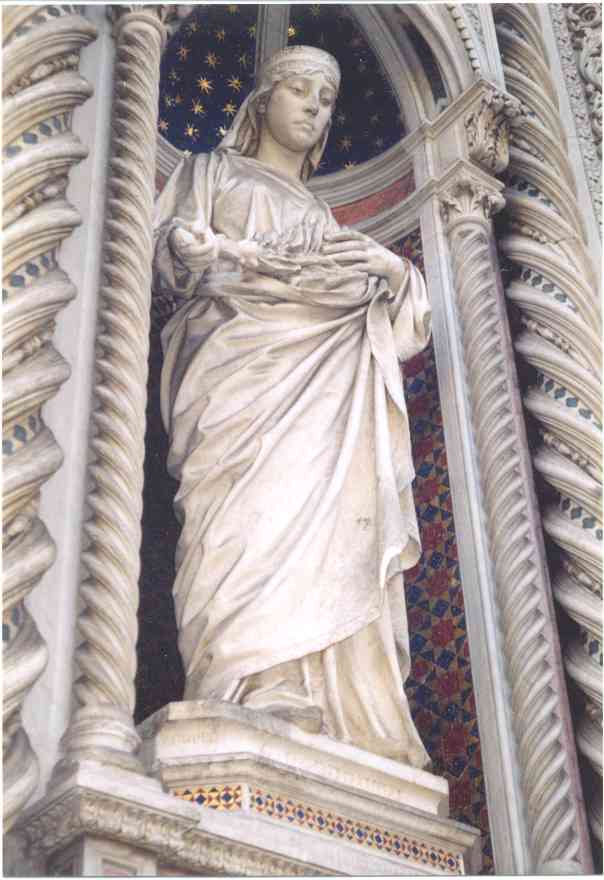
Florence Cathedral, facade, credit Wikipedia

Florence Cathedral, facade, credit Wikipedia
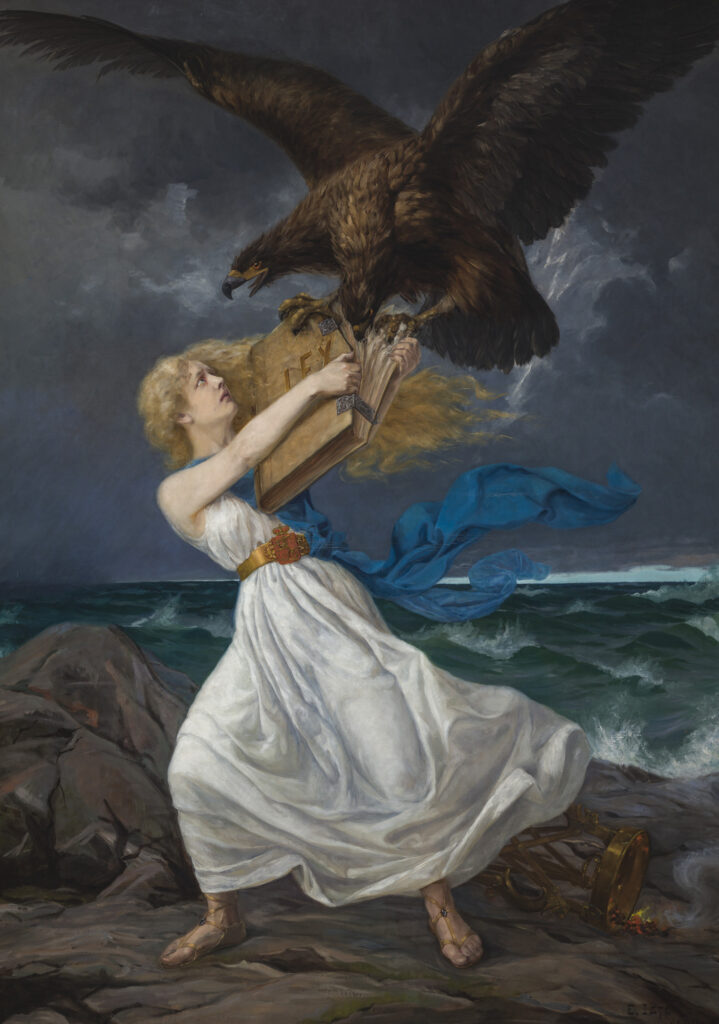
The Attack, Edvard Isto, the Finnish Maiden (Suomineito) attacked by the Russian eagle, credit Wikipedia
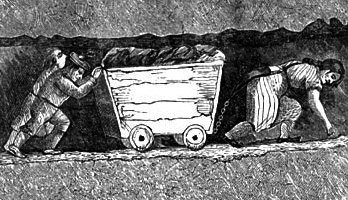
A hurrier and two thrusters, from The White Slaves of England (1853), J. Cobden, credit Wikipedia
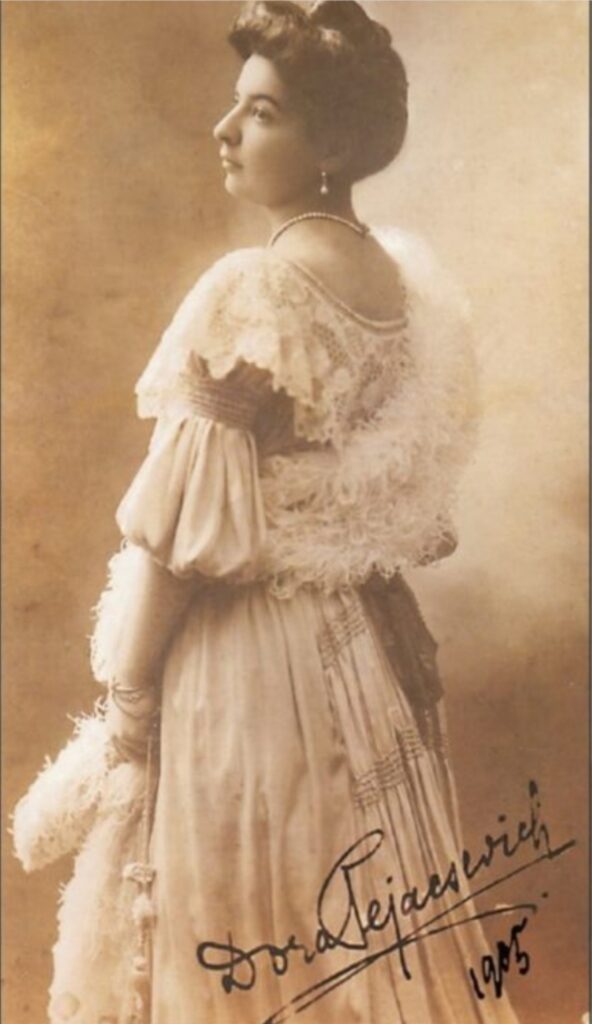
Dora Pejačević, credit Wikipedia
In this edition: a piano concerto and a symphony by Dora Pejacevic; Rachmaninov from the Sinfonia of London; spiritual intensity from American composer, Randall Svane, reviewed by Stuart Millson
A commitment to new and overlooked music has always been at the heart of the BBC Symphony Orchestra’s artistic outlook. During the 1970s and ‘80s, the ensemble tended to perform works strongly connected with either the Second Viennese School, Stravinsky and Bartok, or the avant-garde experimentation of Boulez. Today, the repertoire has softened somewhat: contemporary composers have retuned themselves (at least, in part) to the recognisable outlines of tonality, and programmers have mined a rich reserve of late-romantic/early 20th century figures, such as the Richard Strauss-influenced Croatian, Dora Pejacevic (1885-1923).
Under the baton of Chief Conductor, Sakari Oramo, the BBC SO appears on the Chandos label in glorious depth, in Pejacevic’s Piano Concerto, written just before World War One in which Pejacevic served as a volunteer nurse and premiered in Zagreb in 1916. Despite emerging in the gloom of the European maelstrom, this Great War concerto has significant optimism in many of its great statements; a flourish in its style, and a lyricism that showed how not all art had become doom-laden. Peter Donohoe, renowned for his intense Rachmaninov cycles, is the soloist in this performance, bringing all of his knowledge and authority to bear on an unknown concerto that demands a spirited interpretation, to place it alongside the classic concertos so often heard in the concert halls of Europe.
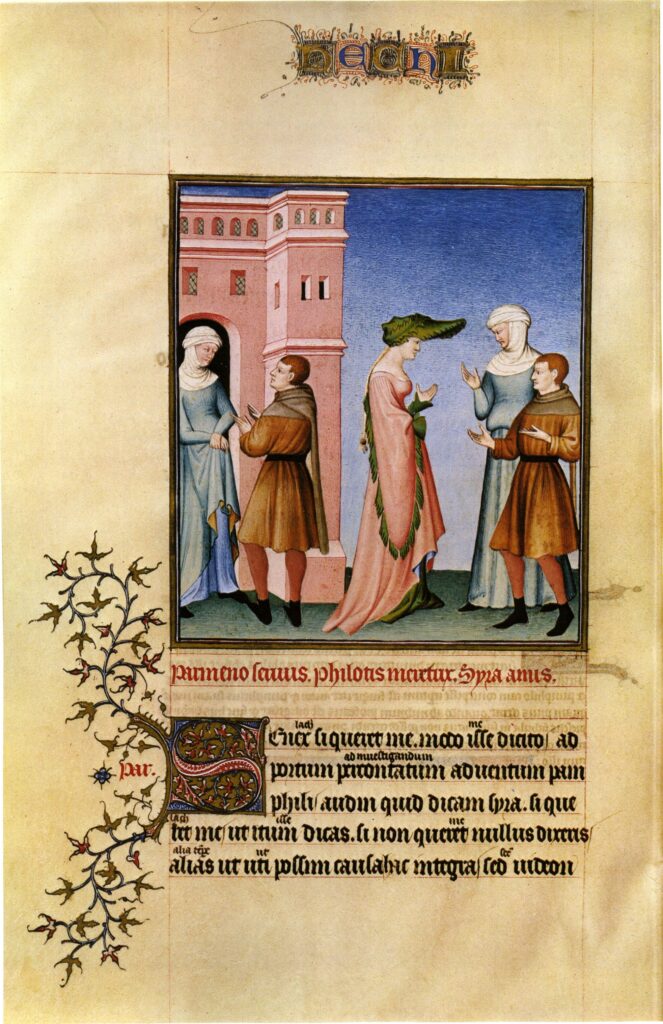
Terence, Hécyre, Paris, credit Wikipédia
Lauren Curtis, Irene P. Garrison, eds., The Lives of Latin Texts: Papers Presented to Richard J. Tarrant, Harvard University Press, Loeb Classical Monograph, 2020, pp. i-xxvii; 1-336, reviewed by Darrell Sutton
Distinguished as a textual critic, RJ Tarrant’s literary insights are combined with a knowledge of Latin syntax. To mark his retirement from the Pope Professorship of Latin Language and Literature, the department of Classics at Harvard organized a conference in 2018. The collectanea now published evidence the admiration in which he is held by students and colleagues. Select comments are due.
Kathleen Coleman remarks on his publications and contributions to classical studies in a paper entitled ‘Richard Tarrant: Scholar, Teacher, Colleague’, after which a 5-page bibliography is appended. The book includes three sections: Part I: Editing; Part II: Seneca, Ovid, and Other Incursions in Latin Literature; Part III: Music. Fourteen papers are included, all astute; some more, some less interesting [see Table of Contents below].
Rebecca Benefiel’s paper ‘Editing Ancient Graffiti’ illustrates her approach to editing ancient handwriting. Providing plenty of figures and illustrations, readers are given opportunities to grapple with expressions that are unclear, with inscriptions that defy dogmatic interpretation. On p.16 she argues that many words should not be “frequently dismissed as misspellings or mistakes”. We beg to differ. Even if we grant the omnipresence of colloquialism, Latin idiom among Romans definitely could be conveyed correctly or incorrectly. These things essentially are matters of judgement. As scholarship advances, it seems likely that rigid assertions about the character of language will go the same way as pronouncements hitherto made on the distinct characteristics of different people. Continue reading
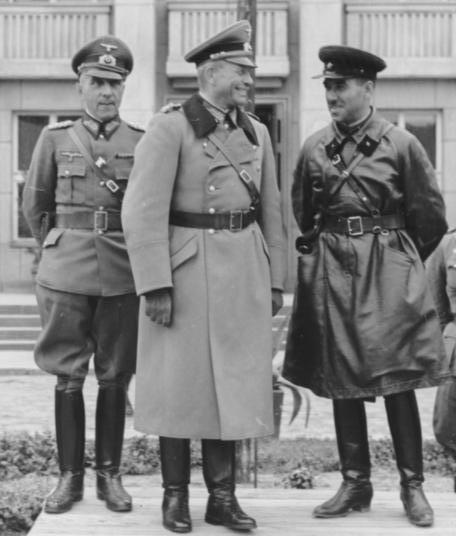
General Heinz Guderian & Brigadier Semyon Krivoshein, Sept 1939, credit Wikipedia
The Devils’ Alliance; Hitler’s Pact with Stalin, 1939-1941, Roger Moorhouse, Basic books, New York, 2014, hb, 382pp, $29.99 US, reviewed by Leslie Jones
As Roger Moorhouse observes in this compelling account, the Nazi-Soviet Non-aggression Pact of August 1939 was “one of the salient events of World War II”. It isolated Poland and thereby led directly to war. In line with the secret protocol of the treaty, Poland was then divided up by “its two malevolent neighbours”. The Soviet annexation of the Baltic states and of the Romanian province of Bessarabia was another direct result of the treaty. Hitler’s occupation of Western Poland subjected the Poles and the Jews to “a horrific regime of exploitation and persecution”. In the aforementioned territories annexed by the USSR, likewise, “class enemies” were killed, persecuted or deported. As the author remarks, Hitler ethnically cleansed Western Poland while the eastern portion was politically cleansed by the Soviets.
Some commentators considered the USSR a “worker’s paradise”, which Stalin was only trying to protect. By means of the pact, they maintained, Stalin enlisted Nazi aggression to accelerate the eventual fall of capitalism. Hitler had been turned West and become an “unwitting tool of the Soviets”. Beatrice Webb, initially appalled, took comfort from the prospect of the Western capitalist democracies being destroyed. Stalin’s policy was “a miracle of successful statesmanship”, she averred. The distinguished future Marxist historian Eric Hobsbawm, then a Cambridge graduate, had “no reservations” about the new party line. “Stalin never errs”, according to some Communists and fellow travellers. Douglas Hyde, a member of the Communist Party of Great Britain, thought that to protect communism, Stalin should, if necessary, “make an alliance with the devil himself”. But Professor Moorhouse dismisses the notion that Stalin’s motive for engineering the Molotov-Ribbentrop Pact was to buy precious time to prepare for an inevitable war with Nazi Germany. He notes that Kingsley Amis, editor of the New Statesman, suspected that the pact’s twin signatories shared something sinister in their DNA. In Le passé d’une illusion; essai sur l’idée communiste au XXe siècle (1995), François Furet subsequently explored this persuasive idea in depth. Continue reading

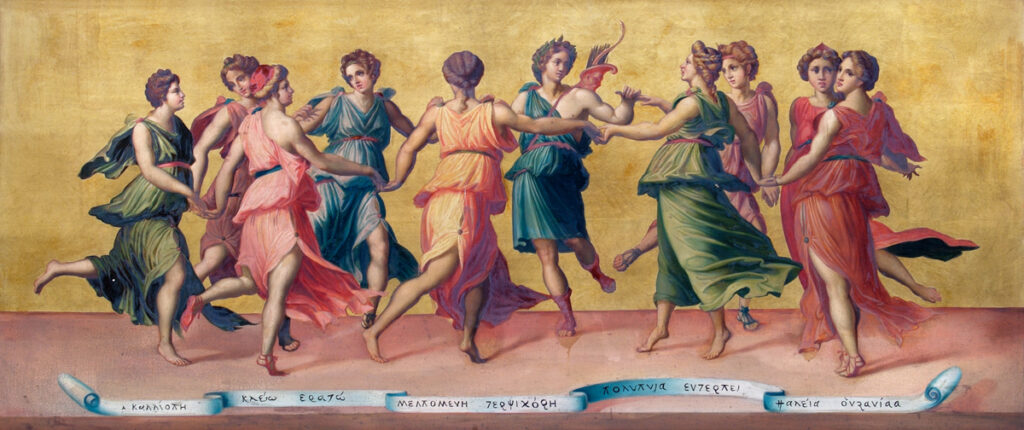
‘Dance of Apollo and the Muses’, Baldassare Peruzzi
In this edition: Haydn from Kent: a fanfare from America, reviewed by Stuart Millson
The East Malling Singers, conductor, Ciara Considine, performed Haydn’s Nelson Mass to warm applause last month, in the fine acoustic of their village church, St. James the Great. Accompanied by a an exceptionally fine line-up of soloists – Gillian Ramm (soprano), Rachael Lloyd (mezzo-soprano), Tom Robson (tenor) and Luke Gasper (bass) – the Singers successfully scaled the heights of the work’s imposing opening, the great Kyrie, which rises in martial mood with timpani and brass to the fore.
Cohesion of voices and a ‘tightness’ in the delivery of many of the more ornate sections of the work carried this Nelson Mass along, as if sailing on a strong tide. The emphatic delivery of the opening section seemed to spur the choir to even greater things in Gloria in excelsis deo; a jubilant release from the brooding introduction. Like Mozart, Haydn possessed that seemingly inexhaustible capacity and inspiration to compose masses (and Masses) of music, in practically every form; from oratorio (the magnificent, The Creation, has also been performed here in East Malling) to chamber works, solo piano pieces and concertos.
Born in 1732, Joseph Haydn was a subject of the Austro-Hungarian Empire and for a great part of his musical life was engaged by the powerful Esterhazy family, for which he composed celebratory pieces, such as a mass for the name day of Princess Marie Hermenegild. The latter work was composed in 1798, not long after Haydn had completed The Creation. Yet he registered the work (completed, incidentally, in the record time of just over 50 days) as: Mass in Straitened Times. Let us not forget that the end of the 18th-century/beginning of the 19th, was a period of extreme political turbulence for Europe; the continent dominated by Napoleon, the sea-lanes by the resisting Royal Navy, hence Haydn’s choice of title.
The first performance took place in Eisenstadt, and it was on a visit to that town in 1800 that Admiral Nelson heard the work; his celebrity conferring a new title on the piece: Nelson Mass. At the time, people sought to find echoes of Nelson’s career and achievements in this forty-minute-long piece. Had not Nelson defeated the French at the Battle of Aboukir Bay in the very same year in which Haydn had composed the mass? That was indeed true, but there is no evidence to suggest that Haydn, in his Austro-Hungarian fastness, would have had any idea of the sea-battle taking place between Nelson and Napoleon’s Mediterranean fleet. Here we truly find a work named because of a happy accident: Nelson simply attending a Haydn concert.
For the East Malling Singers, the great tenderness, generosity and often just simple melodies – such as in the Agnus Dei, or even the gently-rolling, optimistic ending – Dona nobis pacem – provided some heart warming highlights to the evening, but it is surely in the opening of the Credo that Haydn gives us an arc of light: a movement of breathtaking baroque majesty, more than competently taken up by this ‘amateur’ band of voices.
Haydn lived to see the defeat of the combined French and Spanish fleets at Trafalgar in 1805, but not the final demise of that audacious son of Corsica who became Emperor of France. The composer died in 1809, but became forever enthroned as one of the great classical-era composers; establishing that famous canonical trinity which, after J.S. Bach, set the gold-standard for music: Mozart, Haydn, Beethoven.
In the first half of the concert, the choir performed Bruckner’s motet, Locus iste, and Josef Rheinberger’s Abendlied – both works creating an immediate atmosphere of Middle-Europe: dimly-lit churches in Upper Austria, twilight forests in Bohemia; with the tenor, soprano, mezzo and bass soloists also contributing a medley of operatic arias and English song. Offenbach and Bizet sparkled (accompanied by pianists Nick Bland and John Hayden), but for this observer, the piece that truly stood out was Vaughan Williams’s Vagabond, from Songs of Travel. In bass, Luke Gasper’s hands (and in this, the Vaughan Williams 150th anniversary year), we truly found ourselves on the moonlit, open road through rural shires and candlelit villages.
Finally, in complete contrast, a discovery: the music of contemporary United States composer, Randall Svane – his majestic fanfare (a live recording sent to The QR on an mp3 file) also manages brief moments of introspection, as if we are floating above the Appalachian mountains, just pondering the grandeur of the scene. Spans of brass writing bring a Copland-like horizon into view, and at the end, with Randall Svane unleashing his full force, it as if we were leaving the orbit of the Earth altogether on a NASA mission!
We are looking forward to hearing more from this composer, and it looks as though the Three Choirs Festival here in England have recognised his talents: a new work for orchestra, Quantum Flight, is destined to dazzle them soon, at Gloucester Cathedral.
Stuart Millson is Classical Music Editor of QR
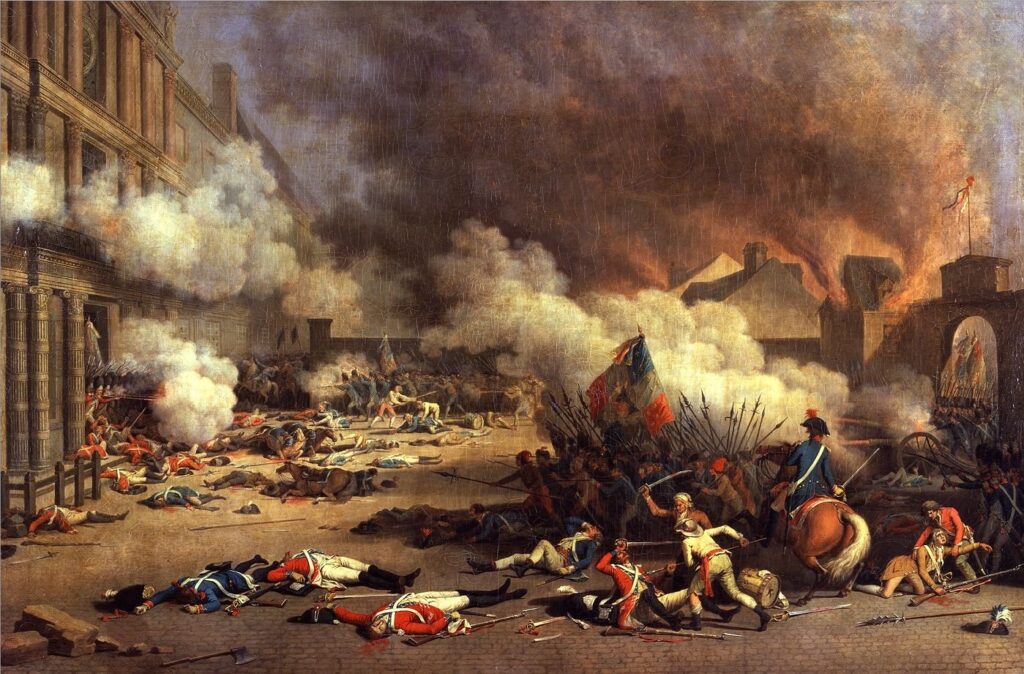
Jacques Bertaux, Prise du Palais des Tuileries, credit Wikipedia
Wollstonecraft: Philosophy, Passion and Politics, Sylvana Tomaselli, Princeton University Press, Princeton & Oxford, 2021, 230pp, pb, reviewed by Leslie Jones
The first riposte to Edmund Burke’s Reflections on the Revolution in France (1790) was Vindications of the Rights of Men (1790), by one Mary Wollstonecraft. Sylvana Tomaselli, a Lecturer in History at St John’s College Cambridge, notes that Wollstonecraft’s thought was profoundly “shaped” by both Burke and Rousseau. [i] She reviewed several of Rousseau’s works and had studied Burke’s A Philosophical Enquiry into the Origin of our Ideas of the Sublime and Beautiful (1757) and his Vindication of Natural Society (1757). Although hardly an original thinker, she was an eloquent writer and a powerful polemicist. Women in contemporary society, she averred, “learn to lisp, to totter in their walk, and nick-name God’s creatures”.
In his Discours sur l’origine et les fondements de l’inégalité (1750), Rousseau maintained that the only inequality in the state of nature was the natural inequality between men, some being stronger and more adroit than others. But, with the establishment of private property and the development of agriculture and industry, the effects of natural inequality were magnified and compounded. Enter inequality of wealth, of social standing and power and all their attendant abuses – to wit, idleness, luxury, poverty, the mutual dependence of the rich and the poor and the selfish wish of the individual to benefit at the expense of others. The upshot was that “Man was born free but is everywhere in chains” (Rousseau, Du Contrat social, 1762). Continue reading